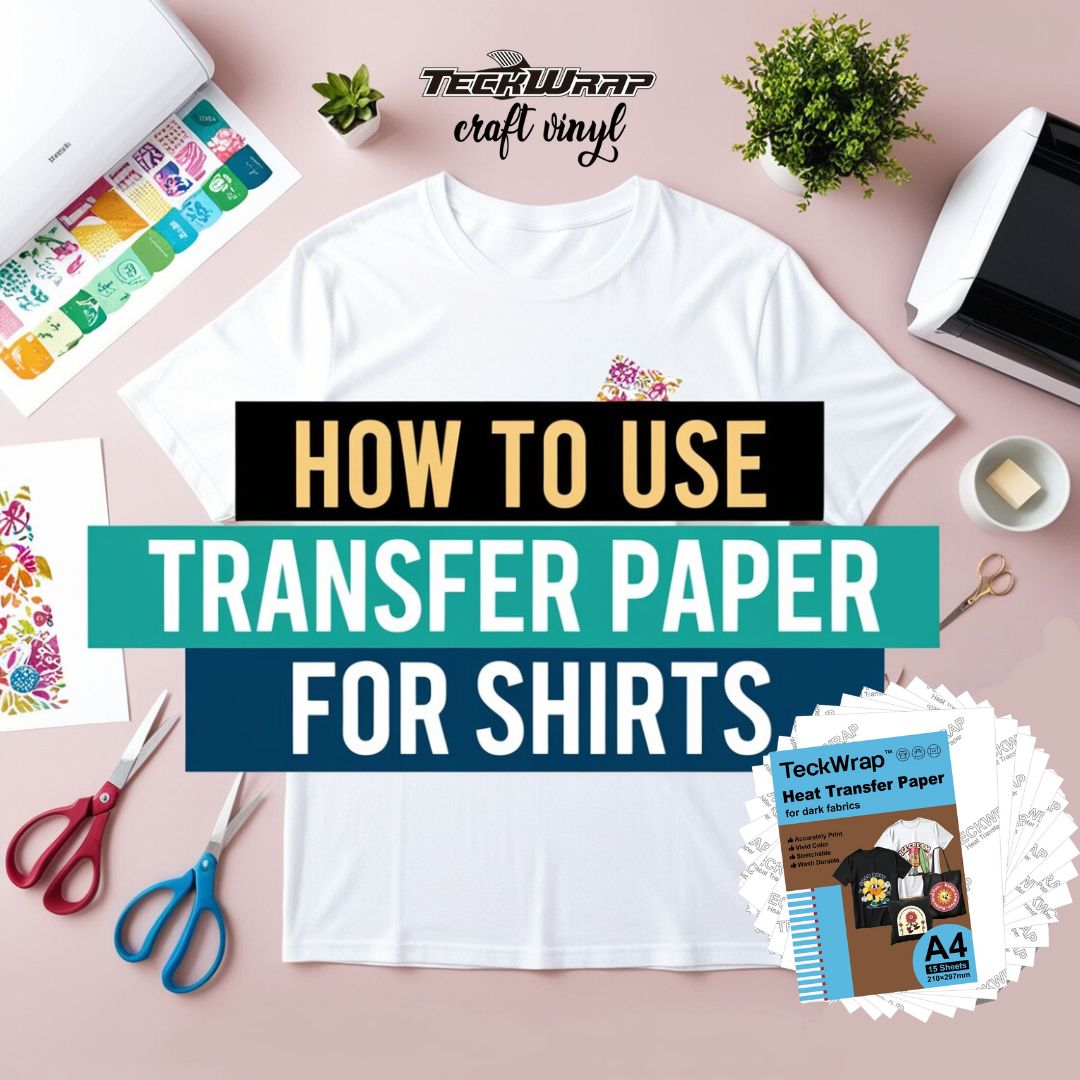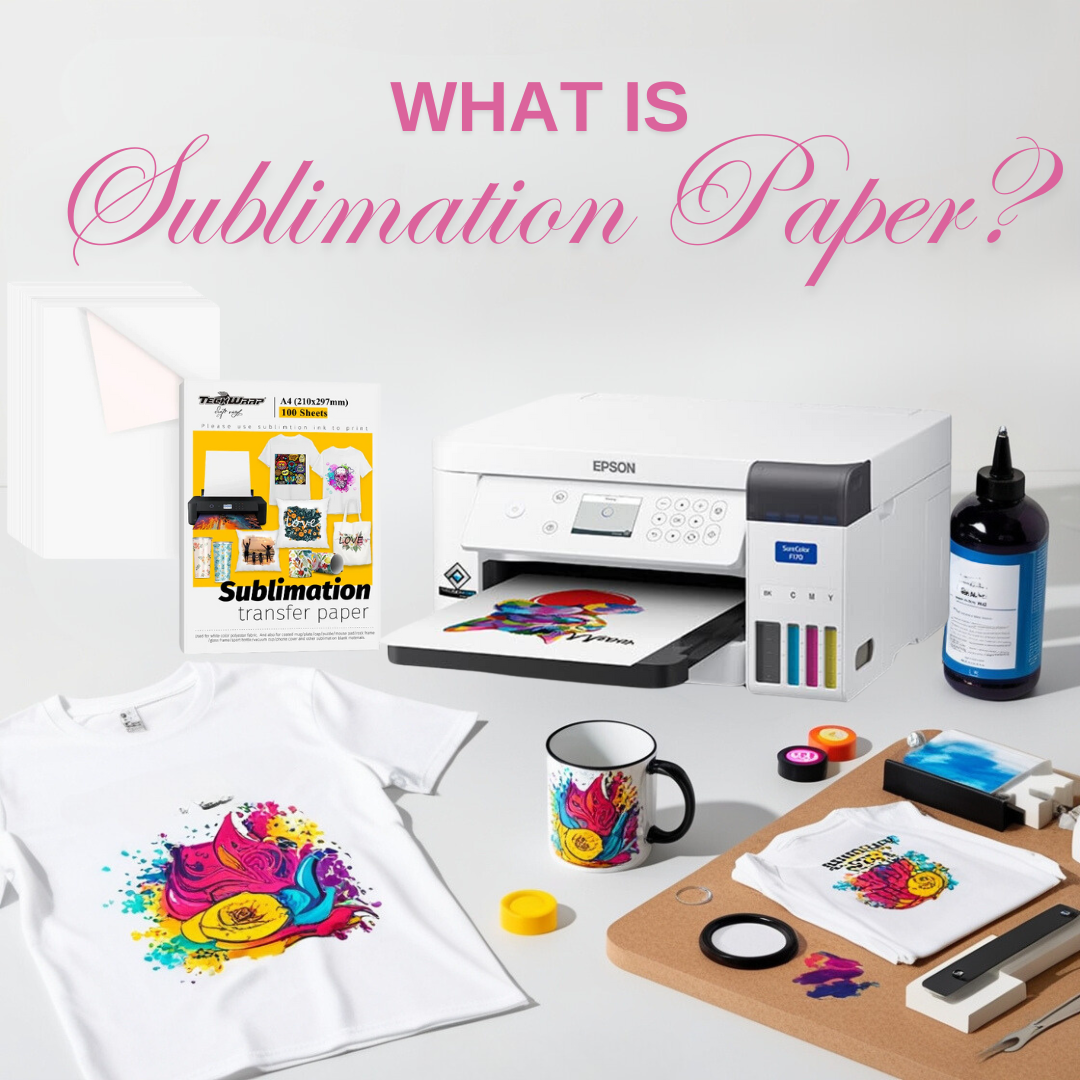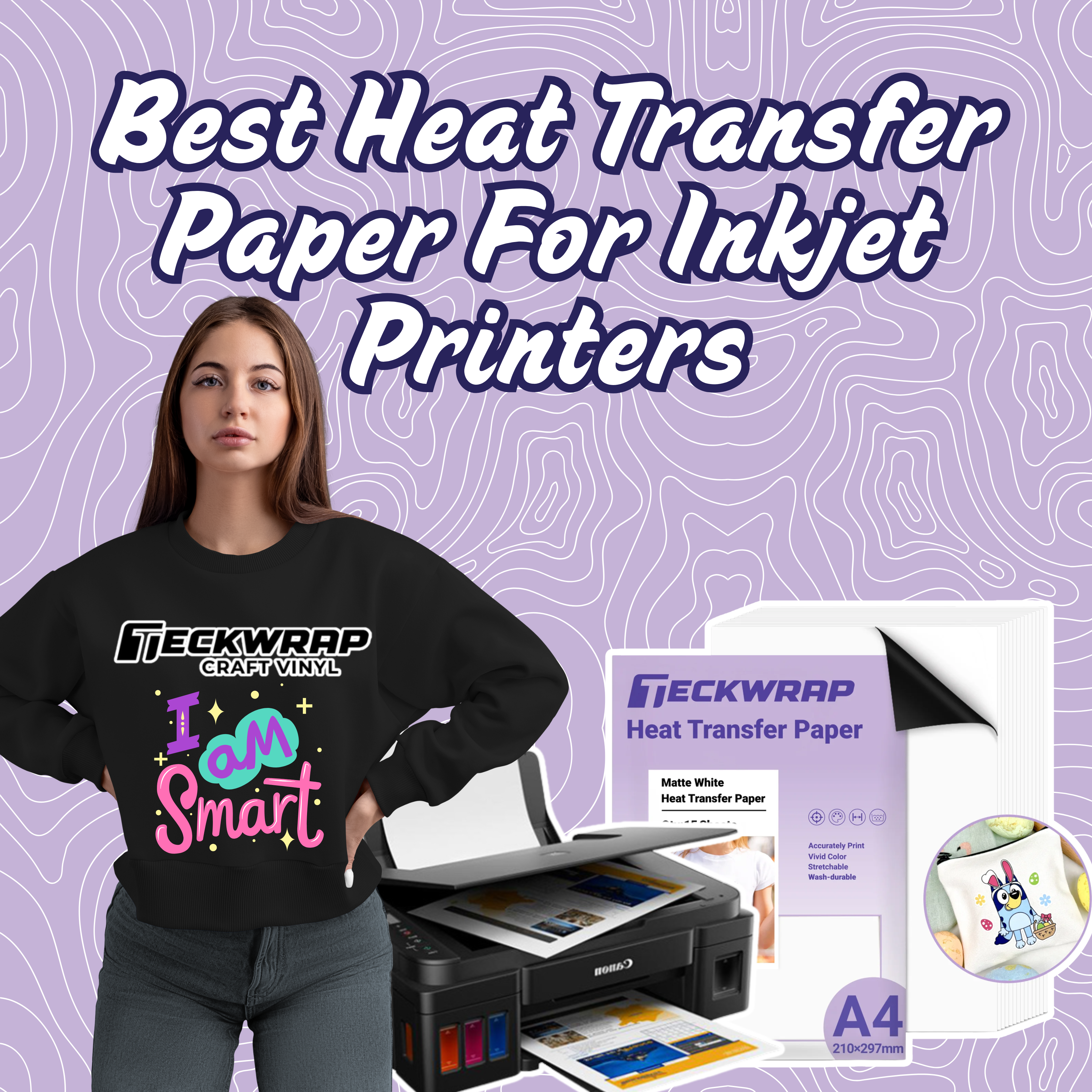Posted By TeckWrap Craft On September 17, 2023
How Long Does Heat Transfer Paper Last?

Table Of Contents
- What Is Heat Transfer Paper?
- Different Types Of Heat Transfer Paper
- How Long Do Heat Transfer Paper Designs Last?
- How To Improve The Lifespan Of Heat Transfer Paper Designs?
- How Long Does Heat Transfer Paper Last When Stored?
- Factors Affecting The Longevity Of Stored Heat Transfer Paper
- How To Use Heat Transfer Paper?
- Where Can You Use Heat Transfer Paper?
- Sublimation Vs Heat Transfer Paper
- Heat Transfer Vinyl Vs Heat Transfer Paper
- Frequently Asked Questions
In the vibrant and creative world of DIY and custom printing, where personal expression knows no bounds, one good tool stands out: heat transfer paper. It is the magic behind those custom T-shirts, vibrant tote bags, and other personalized fabrics that adorn our daily lives. Designs created with heat transfer paper last for 25 to 30 washes.
In this blog, we will delve into the significance of heat transfer paper, unraveling its role in transforming printing endeavors. But beyond its essential utility, we will also shed light on a topic often overlooked — the longevity of heat transfer paper.
Understanding how long this versatile medium lasts is crucial for anyone seeking to make their creations endure the test of time. Join Teckwrap Craft on this journey as we explore the multifaceted world of heat transfer paper, from its pivotal role in the DIY and custom printing universe to the factors that determine its lifespan, ensuring that your creative masterpieces retain their charm.
What Is Heat Transfer Paper?
Heat transfer paper is a specialty paper used to transfer images, graphics, and designs onto pure fabrics using heat and pressure. Unlike transfer vinyl, the ink or toner adheres to the surface when heat is applied, resulting in a vibrant print.
Heat transfer paper allows users to create custom designs on fabrics made with 100% natural fibers such as cotton or linen. It is possible to print intricate and vibrant designs with ease with this paper without much investment. You will only need it with a printer and a heat source.

Different Types Of Heat Transfer Paper
There are differing types of heat transfer papers that are detailed below:
- Inkjet Heat Transfer Paper: Ideal for use with inkjet printers, this paper is designed to absorb ink and produce detailed prints on fabric and other materials.
- Laser Heat Transfer Paper: Geared toward laser printers, this type of heat transfer paper offers exceptional durability and is often used for commercial applications.
There are different heat transfer papers for dark and light fabrics as well:
- Dark Fabric Heat Transfer Paper: This is specifically designed for use on dark-colored fabrics. It typically has a white or colored background that helps the design stand out on dark materials. The design is not mirrored on the software when using this paper.
- Light Fabric Heat Transfer Paper: This is used for light-colored or white fabrics. It doesn't have a colored background so it's ideal for designs where you want the fabric color to show through. The design is mirrored on the software when using this paper.
How Long Do Heat Transfer Paper Designs Last?
Depending on certain important factors such as the quality and thickness of paper, how well it has been stored, and how the design was taken care of, heat transfer paper designs last for about 25 to 30 washes.
After that, you might notice that they have started to crack with little discoloration in the beginning and then evident fading eventually. The print does not outlast the shirt which makes it not a very durable solution for design transfer. It is just affordable and good for temporary prints.
How To Improve The Lifespan Of Heat Transfer Paper Designs?
If you are looking for tips and tricks that can help preserve your heat transfer paper designs, here are a few.

- Store heat transfer paper flat to prevent curling or warping.
- Minimize handling to avoid transferring oils from your skin to the paper.
- Keep the paper in a clean and dust-free environment, preferably in an airtight container or plastic bag.
- Maintain a stable and moderate temperature and humidity level in the storage area.
- Select the appropriate type of heat transfer paper for your specific project and printing method (e.g., inkjet or laser, dark or light).
- The method used to transfer the design onto the paper can also affect longevity. Professional-grade heat presses and equipment tend to produce better results than home iron-on methods.
- The quality of the heat transfer paper itself plays a significant role. High-quality heat transfer paper tends to produce more durable and longer-lasting designs.
- Ensure your printer is in good condition and compatible with the chosen heat transfer paper.
- The material onto which the design is transferred matters. Designs on 100% cotton tend to last longer than on blended fabrics.
- Follow manufacturer guidelines for print settings, including resolution and quality settings.
- Following the manufacturer’s guidelines is crucial to ensure that your paper design does not fade prematurely. This is due to the fact that uneven pressure and high temperature during the heat press process can lead to incomplete transfers and premature wear.
- Avoid overexposing the paper to heat or pressing it for too long, as this can damage the paper and affect print quality.
- Follow proper washing and care instructions for items printed with heat transfer paper to prolong the life of the print. Typically, washing the item inside out in cold water, avoiding harsh detergents, and air-drying rather than machine-drying can help extend the life of the design.
- Exposure to direct sunlight can cause heat transfer designs to fade over time. UV rays can be detrimental to the vibrancy and longevity of the design.
- How much you are wearing the garment with heat transfer paper design also matters. The more frequently an item is used and washed, the faster the design may deteriorate.
- The quality of the design itself, including the ink used and the resolution of the image, can impact how long it lasts. Higher print resolutions and quality settings can result in more vibrant and detailed prints that last longer. Ink and toner are also important factors and using the right ones can improve adhesion and durability.
- Environmental factors such as humidity, temperature fluctuations, and abrasion can affect the longevity of heat transfer designs.
In general, you can expect heat transfer paper designs to last for several washes up to 30 Wash Cycles if they are properly cared for. However, they may eventually show signs of wear and fading, especially if subjected to harsh conditions. The exact duration of their longevity can vary widely based on the factors mentioned above.
By following these tips, you can maximize the longevity of your heat transfer paper and ensure that your custom-printed creations remain vibrant and durable.
How Long Does Heat Transfer Paper Last When Stored?
The longevity of heat transfer paper can vary significantly based on the type and brand you choose.
- Inkjet Heat Transfer Paper: On average, inkjet transfer paper tends to last between 1 to 3 years when stored properly. Premium brands with advanced coatings may offer a longer lifespan.
- Laser Heat Transfer Paper: Laser transfer paper is known for its durability. It can last anywhere from 3 to 5 years in storage under suitable conditions.

Factors Affecting The Longevity Of Stored Heat Transfer Paper
Apart from brand and type, there are various other factors that can either reduce or increase the lifespan of heat transfer.
Storage Of The Heat Transfer Paper
Proper storage techniques are highly imperative. This means that when you are taking a break from printing and want to keep your heat transfer paper for some time, there are a few things to keep in mind. These include storing your heat transfer paper flat to prevent curling or warping, avoiding excessive touching that can potentially compromise adhesion, and keeping the design in a clean and dust-free environment away from sunlight.

Temperature And Humidity
Since this transfer paper is heat-activated, exposing it to higher temperatures and humidity can reduce its longevity. High humidity can cause the paper to curl, making it challenging to feed into the printer or heat press. On the other hand, extreme heat can prematurely activate the adhesive on the paper, making it difficult to achieve a clean transfer. Both of them combined can accelerate ink or toner degradation, leading to faded prints.
Quality Of The Heat Transfer Paper
This is the most important factor as not all heat transfer papers are created equal. The quality of the paper itself can have a significant impact on the lifespan of your prints. Higher-quality transfer paper tends to be thicker and more robust making it less prone to damage during handling and transfer processes. If you want to print and store heat transfer paper, do not compromise on this, and always purchase the high-grade, finest material even if it is at a slightly higher price point.

How To Use Heat Transfer Paper?
The correct application also affects how long the heat transfer paper designs last. Hence we have detailed the correct method of its usage. For knowing about how to use transfer paper for shirts check our blog.
Tools You May Need
The tools you may required are the following:
- Premium quality heat transfer paper. Make sure it is according to the printer you will be using and the color of the fabric on which you will be printing. Use the transparent heat transfer paper if you want to print on white or light-colored shirts. Use white heat transfer paper for darker fabrics.
- A fabric to apply heat transfer paper design onto. You will need one with 100% natural fibers such as cotton or linen.
- Printer. You can use both inkjet and laser printers for the process. Make sure to buy the heat transfer paper according to the type you have.
- Heat Press. You will need this machine to apply the recommended heat and pressure evenly on the design.
- A pair of scissors or a craft knife. If you have an automated cutting machine, you can use it too.
- Parchment paper is needed if you are using heat transfer paper for dark fabrics. This will help distribute heat evenly and prevent the surface from scorching.
The Method Of Using Heat Transfer Paper
- First, you create or select the design or image you want to transfer onto the target surface. This design is typically created using graphic design software or chosen from pre-made designs. Do not forget to mirror the design if you are using heat transfer paper for light fabrics. You do not have to do this if you are using the one for dark fabrics.
- Print the chosen design onto the heat transfer paper using an inkjet or laser printer.
- Cut around your design. Be as precise as possible. Make use of the cutting machine if you have one such as Cricut or Silhouette.
- Press the fabric before applying the design to remove moisture and creases. This will give you a smooth surface.
- If you are using heat transfer paper for light fabrics, the printed design will be placed face-down onto the surface of the fabric you want to customize. For transferring designs on dark fabrics, remove the backing of the heat transfer paper and place it where you want it to be with the design facing up. Put parchment paper on top and then apply heat.
- Place a piece of cardboard or heat press pillow under the fabric to avoid printing on both sides. Using a heat press machine, apply heat and pressure to the heat transfer paper and the target surface. The heat activates the special inks, causing them to transfer from the paper to the surface of the fabric.
- After a set amount of time, the heat transfer paper is removed from the substrate and allowed to cool. During this cooling process, the ink on the paper solidifies and adheres to the surface.
- Once the item has cooled down completely, you have a customized product with the design or image transferred onto it. This design is washable if the proper heat transfer paper and methods are used.

Where Can You Use Heat Transfer Paper?
The versatility of heat transfer paper is truly remarkable, and its applications extend across a wide spectrum of industries.
- Fashion and Apparel: Custom T-shirts, hoodies, and other clothing items adorned with unique designs are a staple of the fashion industry.
- Promotional Products: Businesses use heat transfer paper to create branded merchandise, including promotional bags and t-shirts.
- Home Decor: From personalized cushions to custom-made curtains, heat transfer paper allows you to infuse your home with your unique style.
- Sportswear and Uniforms: Sports teams and athletic organizations use heat transfer paper to print logos, numbers, and names on jerseys and uniforms.
- Arts and Crafts: Craft enthusiasts employ heat transfer paper for a myriad of projects, including handmade greeting cards, scrapbooking, and DIY gifts.
- Signage and Banners: Businesses use heat transfer paper to create eye-catching signage and banners for advertising and promotional purposes.
Sublimation Vs Heat Transfer Paper
Sublimation is another process where specialized paper is used to print exquisite designs onto compatible fabrics with the application of heat and pressure. The mechanism is a bit different though. Special ink and printer are used for sublimation. With heat, this ink converts into gas and permeates the surface of polyester-based materials resulting in permanent prints. For more knowing about what is sublimation paper? The ultimate guide check our blog.
Sublimation is a more reliable process than using heat transfer paper as it is longer lasting. Sublimation designs, if properly taken care of, can last up to the life of the garment. These do not fade or crack easily. Sublimation paper, when stored correctly, can last for several years, maintaining the vibrancy of the transferred colors.
Hence this is a better process to use as compared to heat transfer paper if you want durable, vibrant prints. You can get premium quality sublimation sheets from TeckWrap Craft. For temporary designs, you can opt for heat transfer paper.
Heat Transfer Vinyl Vs Heat Transfer Paper
Using heat transfer vinyl (HTV) and heat transfer paper are both popular methods for customizing garments and other fabric items, but they have distinct differences in terms of materials and application processes:
Heat transfer vinyl is a type of material with an adhesive backing that is activated through heat and pressure application. It is used in the customization of fabrics and other textiles. With HTV, you can create designs, letters, or graphics on clothing items such as t-shirts, sweatshirts, and caps. HTV comes in various colors and finishes, including matte, glossy, metallic, and glitter.
The process of application of both heat transfer vinyl and paper differs significantly. In HTV, there is no transfer of ink, The vinyl material itself is applied with heat and pressure to a compatible fabric such as cotton, polyester, and poly/cotton blends, cut into an exquisite design.
It typically results in a more flexible and lightweight transfer that feels like part of the fabric. However, HTV typically requires a higher temperature and longer pressing time compared to standard heat transfer paper. It also tends to be more durable and long-lasting than heat transfer paper. For more knowing about best heat transfer vinyl check our blog.
Heat transfer paper, on the other hand, has a special coating on one side. This coating is designed to hold the ink or toner from your printer until it is heat-activated. Heat transfer paper is specifically designed for use with either inkjet or laser printers, depending on the type of paper you choose.
With heat transfer paper, you print your design onto the paper, and the design is transferred to the fabric during the heat press or ironing process. It is generally easier to work with for beginners. Heat transfer paper often leaves a thin, flexible film on the fabric. The texture may be slightly different from the surrounding fabric. While it can produce good results, the prints may not be as long-lasting as those made with HTV. For knowing about best heat transfer paper for inkjet printers check our blog.
Frequently Asked Questions
Final Words On The Longevity Of Heat Transfer Paper
In conclusion, the average lifespan of heat transfer paper varies depending on the type, brand, and how well you care for your creations. By choosing the right type, practicing proper storage, and following best practices, you can ensure that your printed items remain lustrous for up to 30 wash cycles, making every project a lasting work of art. Stay tuned for more tips and tricks for all your creative endeavors.








